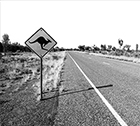Few of us think about how our bodies will be dealt with when we pass on. We assume that, after dying peacefully in our sleep at home or perhaps, less fortunately, in a car-wreck, our mortal remains will be treated respectfully between the time of our death and when we are flung into that final fire or laid in the ground for the worms.
This is true for how most people in the Northern Territory will meet their maker, particularly those who live in cities and larger towns.
But it can be a very different situation in many remote, particularly Aboriginal, townships in the NT.
The pictures above are taken from the cover of a comprehensive 2012 report by then-NT ombudsman Carolyn Richards into the management of morgues in remote townships in the territory and illustrate the very basic standards of morgue services in those townships.
Richards’ report is a comprehensive and very sorry tale of government and bureaucratic duck-shoving and buck-passing.
She began by asking herself a basic question: who is responsible for making sure the deceased receive proper care?
As it stands, no one.
Morgue horror stories from remote service providers and workers included a body temporarily stored in the Timber Creek court room after a motor crash, and another left to decompose in a shed with no air conditioning. The local NT police commander who made these reports said although the latter was “not looked favourably upon”, it was “the only option at the time”.
Richards summed up her concerns — and barely concealed frustrations — with the failure to address long-standing concerns expressed by residents and staff dealing with these issues:
“The result of this investigation confirms that there is no ‘appropriate NT Government Department’ to whom responsibility and resources for the establishment, maintenance and management of morgues rests.”
Notwithstanding the dramatic and urgent issues raised by Richards in 2012, it appears that not much progress has been made in the last two years.
In his recently released annual report, the current Ombudsman Peter Shoyer noted that despite the eight recommendations made in 2012, reports from the Northern Territory government revealed that little was being done to change things. Shoyer’s report contained the most recent update from the Chief Executive of the Department of Community Services dated September 8, 2014, revealing that:
“Since the modelling was carried out in 2011 there have been no significant changes in death and burial data, and it is our view that a locally based funeral business is still not viable in any remote NT community.
“The Department has prepared advice on remote morgues policy options and presented this in a report to Government who are still considering the best policy options for future morgue management.”
Shoyer’s response was damning. “This issue has not resolved itself or dissipated with the course of time,” he wrote. “In the absence of clear direction and governance from the Northern Territory Government, the potential for deep personal anguish remains.”
Shoyer made reference to a terrible situation in Wadeye when a man’s body was mistakenly swapped with the body of a young woman. The error was only discovered at the time of the man’s funeral.
Ombudsman Shoyer’s understated response to this matter speaks volumes: “The need for a concrete strategy to deal with this issue remains pressing.”









Crikey is committed to hosting lively discussions. Help us keep the conversation useful, interesting and welcoming. We aim to publish comments quickly in the interest of promoting robust conversation, but we’re a small team and we deploy filters to protect against legal risk. Occasionally your comment may be held up while we review, but we’re working as fast as we can to keep the conversation rolling.
The Crikey comment section is members-only content. Please subscribe to leave a comment.
The Crikey comment section is members-only content. Please login to leave a comment.